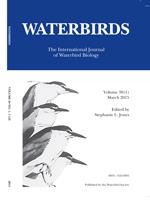The Black Guillemot (Cepphus grylle) is a monomorphic seabird characterized by its muted plumage and bright red feet, which it prominently displays during courtship. Foot color and oxidative stress were analyzed in a Black Guillemot colony at the Bay of Fundy during the 2006 and 2007 breeding seasons. While no relationship between red intensity of feet and carotenoids was uncovered, the level of plasma oxidative damage was negatively correlated with foot color. Additionally, red intensity of male feet was significantly correlated with the red intensity of their mates' feet, suggesting the possibility of assortative mating by foot color in this species. Further experimental work is necessary to determine whether foot color is used in this species as an honest signal to relay information on the ability of an individual to manage oxidative stress.
How to translate text using browser tools
1 March 2015
Monomorphic Ornamentation Related to Oxidative Damage and Assortative Mating in the Black Guillemot (Cepphus grylle)
Vincent J. Fasanello,
Elizabeth D. Carlton,
Maddie Pott,
Nicole M. Marchetto,
Emily Vaughn,
Kevin J. McGraw,
Robert A. Mauck,
Mark F. Haussmann
ACCESS THE FULL ARTICLE

Waterbirds
Vol. 38 • No. 1
March 2015
Vol. 38 • No. 1
March 2015
assortative mating
Black Guillemot
carotenoids
Cepphus grylle
color
oxidative stress
visual signals




